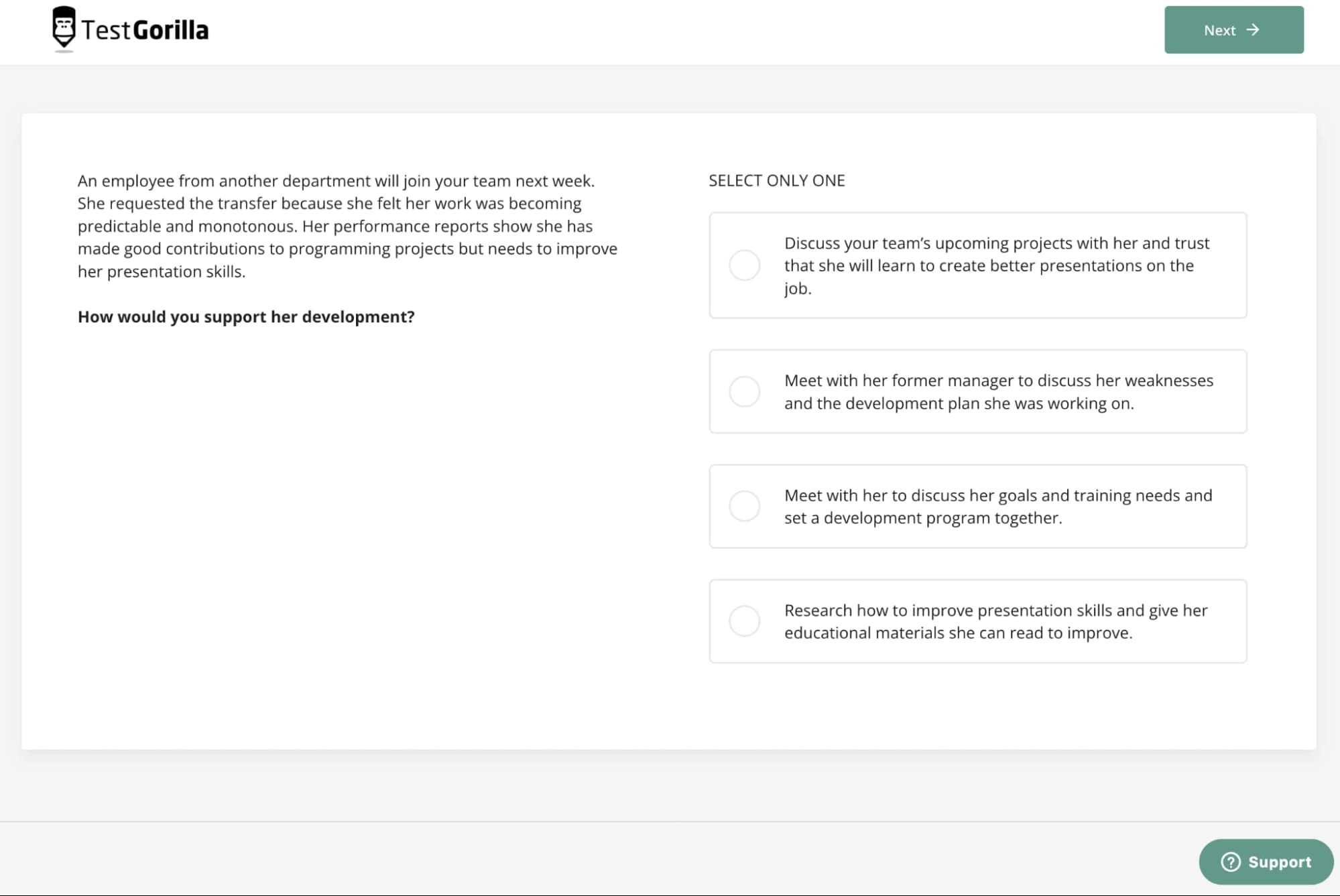Leadership communication: Leverage this retention strategy and build workplace trust
A Trust in the Workplace survey found that most employees (79%) had more trust in their peers than in their leaders.[1]
This lack of trust often stems from poor communication, which can lead to a toxic work environment and weak organizational culture – driving your best talent away from your company.
However, you can avoid this outcome by actively utilizing leadership communication as a talent retention strategy.
Strong leadership communication helps you to:
Improve employee engagement
Boost employee motivation
Build essential workplace trust
Along with training your leaders in communication practices, you can also use talent assessments to objectively gauge leadership communication skills and find the most effective managers for your workforce.
In this guide, we cover the benefits of leadership communication and how it plays into employee retention trends, along with best practices for establishing good leadership communication in your organization and case studies to help you get the most out of this strategy.
Table of contents
- What is leadership communication?
- Why is communication important in leadership?
- The benefits of effective leadership communication
- 8 best practices for leveraging leadership communication to retain your best performers
- 3 examples of companies succeeding with effective leadership communication as a talent retention strategy
- Let trust grow in your business with strong leadership communication
What is leadership communication?
Leadership communication is how leaders use top-down communication to present ideas to their employees, strategize, delegate tasks, set guidelines, and give or gather feedback.
Leaders with effective communication skills are able to understand how they're being perceived and improve the quality of communication between each employee and themselves.
Good leadership communication builds trust between employees and your company. When employees trust the organization, they engage more with the business objectives and perform better.
Leaders who can clarify the company's culture and structure while leading by example help employees better align with organizational goals. Strong communication like this results in a more open exchange of ideas, increased cooperation between employees, and a greater willingness to give and receive honest feedback.
Key leadership communication skills
There’s more nuance to leadership communication than just talking directly to employees.
The eight most important aspects of this strategy are:
Let’s quickly take a look at each of these key leadership communication traits:
Adaptability: Adjust your communication style to work better with different employees – for example, a shier, more reserved employee may be put off by a direct approach
Active listening: Being able to actively listen means creating an environment where employees feel valued and eliciting more useful insights at the ground level
Transparency: Transparency breaks down communication barriers and fosters trust
Clarity: The more clear you are with your communication, the fewer misunderstandings there will be regarding objectives
The ability to ask open-ended questions: Open-ended questions help you to dig deeper into your employees’ motivations, thoughts, and goals
Empathy: The more you can recognize and appreciate the emotions and backgrounds of your employees, the more they feel their voices are being heard and appreciated
Body language: Make sure your body language conveys friendliness and openness to build trust and motivate your employees
Receiving and taking action on feedback: You should always follow through with any feedback given, or you risk disengaging your employees
Why is communication important in leadership?
Strong leadership and strong communication go hand in hand.
Surveys from Gallup's global database show that only one-third of employees have faith in their organization's leadership.[2]
When this type of communication is inadequate, essential details can be misunderstood, resulting in strained relationships and creating obstacles that hinder progress.
Minor miscommunications can escalate into conflict, and if this happens between a leader and an employee, it can cause serious repercussions. Resentment among other staff members builds up, the manager becomes increasingly irritated, and the workplace environment deteriorates.
But good communication is unfortunately not a widespread trait. A study published by Harvard Business Review indicated that nearly seven out of ten managers feel uneasy when communicating with their staff.[3]
The best leaders help employers by maintaining a clear and confident line of communication with everyone. In doing so, these leaders develop a deeper understanding of relevant situations, issues, shortcomings, and opportunities while delivering clear feedback and instruction that steers the ship in a purposeful direction.
Leaders who demonstrate exemplary communication skills effectively “lead from the top” and promote great communication practices throughout the organization.
Your employees benefit because they better understand the meaning of their work and the details behind it. This defined purpose supplements your corporate reputation and boosts employee motivation as they are able to understand how their work contributes to the company’s success.
The best insights on HR and recruitment, delivered to your inbox.
Biweekly updates. No spam. Unsubscribe any time.
The benefits of effective leadership communication
There are many benefits of strong leadership communication, including positively impacting retention rates, boosting engagement, and building trust in the workplace.
Let’s break these down in detail.
1. Improves employee retention
Building strong leadership communication helps improve your employee turnover rate.
Three out of 10 people say uncaring and uninspiring leaders were the main reason they left a role.[4]
Creating an environment of open dialogue in the workplace is a great way to show employees that you care about them. The best leaders do this by actively engaging in conversation, acknowledging worries, giving feedback, and acting on ideas.
This kind of powerful team communication increases employee retention rates by 4.5 times compared with businesses that lack effective leadership communication in the workplace.[5]
2. Boosts engagement
The value of employee engagement can't be overstated – people who are invested in their work are more likely to remain with the company, provide better customer service, and ultimately lead to improved organizational results.
But how do you build this engagement?
The answer is in your company culture – with 63% of workers claiming they would be more engaged if their organization improved its culture.[6]
Your leaders play a crucial role here, as they act as the frontline of your employer branding. Good leadership communication helps employees buy into the company’s vision, instilling the importance of organizational values in the leader’s team.
3. Builds essential workplace trust
Trust in the workplace is a feeling of security, openness, and respect among staff and managers.
It can be hard to cultivate a sense of trust and respect in the workplace when managers keep their employees at a distance and give off an aura of “not approachable” and “no time for you.”
Leaders who act openly and sincerely not only foster interpersonal trust, but trust in the organization as a whole. When there is trust in the workplace, it can positively affect employee wellbeing, work relationships, and employee professional growth.[7]
Want to know more about how employees feel about their leaders? Check out our leadership development statistics guide for deeper insights
8 best practices for leveraging leadership communication to retain your best performers
Now let’s dig deeper into how HR managers can guide leaders to become better at leadership communication.
These eight best practices are geared to helping you make the most of our leadership communication as a method for retaining top talent and driving productivity.
Strategies for using leadership communication to boost retention: A summary
Best practice | Summary |
1. Hire the right leaders from the start | Use skills assessments to quickly find strong leaders both internally and externally |
2. Encourage honesty and transparency | Emphasize transparent communication from your leaders to build trust and motivation |
3. Take action on promises | Encourage leaders to keep their promises and to follow through with their words |
4. Give important details, but don't overcomplicate the comms | Stress to your leaders to communicate important details as clearly as possible so that nothing gets lost in translation |
5. Don't just talk, listen | Coach your leaders in the art of active listening and to practice employee listening with intent |
6. Encourage a culture of open communication and feedback | Help leaders build a workplace culture where employee feedback and open communication is welcomed |
7. Ensure communication is inclusive | Guide your leaders on how they can communicate in an inclusive manner to make everyone feel valued |
8. Be authentic and human | Encourage your leaders to be authentic and to own their roles |
1. Hire the right leaders from the start
Great leaders are rare – so rare, in fact, that 82% of the time, companies hire the wrong candidate for a managerial position.[8]
Getting a sense of leadership skills is hard because they aren't as tangible as other skills, like coding or market analysis.
Talent assessments give you an objective way to gauge a candidate’s skills, such as their ability to communicate, making them a non-negotiable step in hiring great leaders.
The improved accuracy that talent assessment tests bring to your hiring alleviates other potential issues that can result from a leadership mishire, including:
Reduced recruitment costs. Skills-based hiring helps you make the right hire the first time, along with speeding up your hiring process.
Less stress on existing team members. Hiring leaders with poor communication can aggravate problems within your workforce, harming your retention.
Along with communication, talent assessments can be used to judge other important leadership traits, such as people management.
Implementing talent assessments in your onboarding process also helps you identify potential leadership skills in your new hires, which you can use to inform your leadership development plans. This can be an awesome way to increase internal mobility in your organization.
2. Encourage honesty and transparency
HR managers should encourage their leadership to be more transparent and honest in their communication.
A lack of transparency can lead to a toxic work environment, which is one of the top reasons many employees leave their jobs.
Employees trust leaders who are candid and forthcoming, particularly in tough situations.
At town halls or all-hands meetings, suggest to your leaders that they be honest and open about difficulties instead of avoiding or covering up any issues. This breeds trust, loyalty, and respect, which can reduce your employee attrition rates.
Your leaders can also emphasize career transparency (one of the many types of transparency) by regularly communicating your company’s internal and career development opportunities to their team members.
3. Take action on promises
Make sure your leaders understand the importance of following through with what they say.
Failing to keep one's word is sure to shatter the environment of trust you’re working to build.
Aside from this being the right thing to do from a human standpoint, there are business reasons for doing this, too. Studies confirm that employees who feel heard are more engaged, which leads to greater retention and productivity.[9]
Strong leadership communication and taking action on promises can help build a people-centric organization that shows the company is more focused on taking care of their employees than just using them to fulfill a need.
Putting importance on employee wellbeing in this way naturally fosters a strong culture that employees and job seekers are looking for.
4. Give important details, but don't overcomplicate the comms
Communication from leadership must be clear and succinct, focusing on only what’s necessary.
Employees do not want to have to navigate a complex web of information while performing their roles just to get to the key points their leaders are trying to convey. This causes undue stress as they end up feeling like they’ve been left in the dark.
Even worse, if the topic is critical but conveyed inadequately, the important data can get lost or misinterpreted, leading to further confusion among employees.
To avoid this, ask team members in a leadership position to think about entering all communication scenarios with a clear plan. Coach them on ways to improve their workplace communication so that communication across teams is consistent and efficient.
A good leader should be able to relay the bigger picture and other complex topics to their employees in a manner that's both easy to comprehend and familiar so that the ideas can inspire the team.
For example, sentences that are too long or roundabout can make it difficult to comprehend the core message. Effective leaders should also invite questions and encourage their team to ask for clarification about executive decision-making.
5. Don't just talk, listen
A huge component of excellent communication is active listening.
Active listening helps build a company culture that improves retention because employees feel valued as people, not just cogs in the machine.
But there’s more to listening than simply hearing what the other person says. It’s essential to show the other person that you understand what they’re saying and respond appropriately.
One way for leaders to be better listeners is by asking questions when their employees come to them with issues or suggestions and being empathetic in their responses. This lets employees know that their voice is being heard and valued.
You can also encourage your leaders to mingle with their employees, get to know them on a personal level, ask for their input, and truly listen to what they have to say. One on one meetings are a great opportunity for this kind of direct leadership communication.
Build positive working relationships throughout the organization with active listening skills, and you can reap the benefits of better communication.
6. Encourage a culture of open communication and feedback
A culture of feedback is an organizational environment where employee feedback isn't just welcomed but actively encouraged and integrated into daily operations.
You can guide your leaders to create a culture of employee feedback and build a better workplace by:
Offering regular updates
Making objectives and results public
Opening their door to employees
Being open to constructive feedback
Acknowledging feedback and taking action
Making effective communication in leadership in the workplace a routine
Promoting the use of different communication channels to be more inclusive
Sharing their own feedback and ideas
Admitting mistakes
Asking for their own feedback
Employee feedback is also a modern-day tool for retaining employees. Organizations that don’t have an employee feedback system in place experience a 14.9% higher turnover rate.[10]
However, a strong feedback system goes beyond the traditional top-down model of feedback from managers to employees, encouraging upward feedback as well.
Tell your leaders to let people know that they appreciate their input, perspectives, and opinions. When someone voices a different opinion, let them present their whole argument, ask questions, invite input from other people, and let them know their opinion will be considered.
Being truly receptive to comments and criticisms in a group setting or team-based activity nurtures psychological safety in the workplace. This encourages innovation and creativity while also being a strong foundation for employee engagement.
7. Ensure communication is inclusive
The art of inclusive leadership and communication relies on realizing how employees communicate daily and mirroring those behaviors.
The way one speaks and the choice of words used can have a major effect, either beneficial or detrimental, on how staff members feel.
Inclusive and respectful communication enhances creativity, innovation, and problem-solving by embracing diverse ideas and feedback. Additionally, it can reduce conflicts, misunderstandings, and grievances by addressing issues openly and constructively
Motivate your managers to be aware of the influence of verbal and written communication, as it can determine how welcomed an employee feels in the office environment.
For a simple example, consider a situation where the last employee out the door accidentally forgot to turn the lights off. The leader sends an email out to this employee as a reminder.
Poor communication in this situation may look like:
“Why did you leave the lights on in the office last night? You know that if you are the last out, you need to turn them off. This runs up the electric bill and costs the company money for no reason. Do not do this again in the future.”
This communication takes an accusatory tone, pointing the finger at the employee and berating them, making them feel like they’ve made a huge mistake and pushing them away in the end.
A better approach might read:
“We noticed that the lights in the office were left on overnight. I know you were wrapped up in a lot of work, and we all make this mistake from time to time, but can you be sure to check when you are the last one out? Thank you for your continued hard work!”
This text takes a much more amiable approach and emphasizes how the organization values the employee, reaffirming that they belong here.
HR leaders can establish a system that gives everyone in the company more opportunities to communicate in an inclusive way and teach team leaders how they can use it to their advantage. This might include instituting inclusive regulations, forming committees for diversity in the workplace and inclusion, or providing education on fostering an inclusive culture.
8. Be authentic and human
Leaders should communicate in an authentic, approachable way.
Employees can tell when leaders aren't sincere, and they're putting on a corporate mask.
Under the guidance of a genuine leader, employees don't feel scared or that they have to pretend to be liked. They're comfortable voicing their thoughts and opinions, leading to a 30% increase in productivity.[11]
Managers with the right authority can bridge the gap and provide staff with the opportunity to expand and progress in a supportive atmosphere. Their team members take pride in their work, leading them to be 2.3 times more engaged.[12]
Let your leaders know that being a genuine and successful leader starts with improving oneself.
Investing in themselves through such avenues as taking an online course about leading authentically can help them feel more confident in their leadership role.
Having an acute understanding of oneself is a necessary quality for any successful leader. Additionally, research done by Korn Ferry shows that companies that employ leaders with a greater understanding of themselves are more likely to have a higher financial success rate.[13]
3 examples of companies succeeding with effective leadership communication as a talent retention strategy
Effective leadership communication is sweeping the world, and many companies are using it to their advantage as a talent retention strategy.
Let’s zoom in on three great leadership communication examples.
Example of successful leadership communication for talent retention: A summary
Company/Leader | Summary |
Richard Branson | Uses open and sincere communication to build strong work connections and to unite his team |
Credit Karma | Leaders at Credit Karma use an open door policy, and they encourage their staff to come to them with any type of question |
HubSpot | Uses a Wiki page where employees can ask questions directly to team leaders |
Richard Branson's approach to leadership
Richard Branson, the creator of the Virgin Group, is renowned for the way he invigorates and encourages his workers and investors with his communication.
He speaks in a straightforward manner to express his purpose and stresses the value of openness and sincerity in all types of corporate communication. Branson has a talent for fostering a sense of camaraderie and teamwork, relying on his communicative talents to make robust connections and unite his employees.
Richard Branson also encourages leaders to tackle altercations. He says:
“Some leaders try to avoid any sort of conflict in the misguided belief that this will make them more popular among their staff. Neglecting to address an issue while it is still at a manageable level runs the risk of it escalating into a much more serious problem that's more difficult to solve and can have damaging consequences for the future.”
The key to his success in the face of conflict is turning it around and making it an opportunity to grow and bond, which you can do with active listening, being honest and transparent, and acting on promises.
Credit Karma’s open-door policy
Credit Karma, a multinational personal finance company, focuses on building transparency between its higher-ups and employees.
One way it does this is with an open-door policy, which means that its managers and team leaders “always leave their office doors open,” and employees are free to come to them with any question at any time.
Maintaining open communication between employers and employees helps ensure that any issues can be addressed at an early stage while creating a positive and trusting environment that encourages the sharing of ideas and opinions. This helps to create a better and healthier work environment.
However, as Ken Lin, the founder and CEO of Credit Karma, states, having an open door is only one part of the solution to creating a transparent and trusting work environment. He also uses open town halls, where he can share information, recognize employees for their work, and give his people time to ask questions either in person or anonymously.
These sessions have sparked conversations on tips like office upgrades, stock options, company strategy, expansion plans, and even bartending robots – but most importantly, it enabled him to get real with his employees and ensure they’re comfortable enough to come to him about anything.
HubSpot’s question-friendly environment
HubSpot has obtained numerous accolades for its corporate culture, which has been established by the knowledge-based atmosphere the company supports.
Dharmesh Shah, co-founder and CTO of HubSpot, once wrote a piece on his wiki page labeled “Questions for Dharmesh.” It was designed to improve the dialogue between the CTO, leadership, and the rest of the employees. By encouraging its staff to question and debate, HubSpot was able to improve its performance.
Gathering questions and answers in the workplace is one way to build a more open and transparent environment, enabling everyone to offer their ideas and work together to resolve any issues.
Let trust grow in your business with strong leadership communication
Great leadership communication boosts engagement, productivity, and trust, all while making your organization a more attractive place to work.
Employees want to work for great leaders, which is why leadership communication is such a powerful employee retention strategy.
Adopt a few of these best practices to help the leaders at your company, such as encouraging a culture of open communication and feedback and using team leader tests to find great managers.
Discover more about how to hire the right people for leadership and other roles by focusing on skills such as communication and critical thinking.
Sources
1. "Edelman Trust Barometer". (2022). Edelman. Retrieved December 8, 2023. https://www.edelman.com/trust/2022-trust-barometer/special-report-trust-workplace
2. Harter, Jim. (June 13, 2019). “Why Some Leaders Have Their Employees' Trust, and Some Don't”. Gallup. Retrieved December 8, 2023. https://www.gallup.com/workplace/258197/why-leaders-employees-trust-don.aspx
3. Soloman, Lou. (March 9, 2016). “Two-Thirds of Managers Are Uncomfortable Communicating with Employees”. HBR. Retrieved December 8, 2023. https://hbr.org/2016/03/two-thirds-of-managers-are-uncomfortable-communicating-with-employees
4. "The Great Attrition is making hiring harder. Are you searching the right talent pools?". (July 13, 2022). McKinsey. Retrieved December 8, 2023. https://www.mckinsey.com/capabilities/people-and-organizational-performance/our-insights/the-great-attrition-is-making-hiring-harder-are-you-searching-the-right-talent-pools
5. "Employee Retention Strategies". (2022). ZenHR. Retrieved December 8, 2023. https://assets.ctfassets.net/r18zc2po1g62/1MY8miRXspbihcCUynvtz6/c1b20bfbdd948221188219514657aa7e/Employee_Retention_Strategies_For_2022.pdf
6. Wooll, Maggie. (June 14, 2022). “Your workforce is lonely. It’s hurting your business.”. BetterUp. Retrieved December 14, 2023. https://www.betterup.com/blog/connection-crisis-impact-on-work
7. "Achievers Report Uncovers How Employers Can Drive Retention amid the Great Resignation". (February 8, 2022). Achievers. Retrieved December 8, 2023. https://www.achievers.com/press/achievers-report-uncovers-how-employers-can-drive-retention-amid-the-great-resignation/
8. Harter, Jim; Beck, Randall J. “Why Great Managers Are So Rare”. Gallup. Retrieved December 8, 2023. https://www.gallup.com/workplace/231593/why-great-managers-rare.aspx
9. "How to Make Employees Feel Valued". People Element. Retrieved December 8, 2023. https://peopleelement.com/how-to-make-employees-feel-valued/
10. Apslund, Jim; Blacksmith, Nikki. (May 3, 2011). “The Secret of Higher Performance”. Gallup. Retrieved December 14, 2023. https://news.gallup.com/businessjournal/147383/secret-higher-performance.aspx
11. Henley, Sue. (August 18, 2016) “What is authentic leadership?”. HR Magazine. Retrieved December 8, 2023. http://www.hrmagazine.co.uk/article-details/what-is-authentic-leadership
12. Bernardin, Nina. (February 15, 2018). “Why It Pays to Help Employees Be Authentic”. SOCAP Global. Retrieved December 8, 2023. https://socapglobal.com/2018/02/pays-help-employees-authentic/
13. "A Better Return on Self-Awareness". Korn Ferry. Retrieved December 8, 2023. https://www.kornferry.com/institute/647-a-better-return-on-self-awareness
You've scrolled this far
Why not try TestGorilla for free, and see what happens when you put skills first.




















